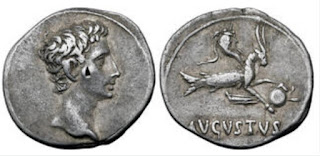Makara (in Sanskrit, pronounced Makar), is a legendary sea-animal, crocodile in Hindu mythology. In Hindu astrology, Makara is equivalent to the Zodiac sign Capricorn. A common word in Hindi often used is Makar Rashi. Makar is the origin of the Hindi word for crocodile, (magar). It is generally depicted as a half terrestrial animal in the frontal part (stag, deer or elephant) and half aquatic animal in the hind part (usually of a fish, a seal or a snake, though sometimes a floral tail is depicted). Though Makara may take several forms in Hindu culture, in the modern world, its form is always related to the marsh crocodile or water monitor.
During Vedic times when Indra was the God of heaven, Varuna (the water God) became the God of the seas and rode on Makara, which was called ''the water monster vehicle''.
Vishnu's earrings are shown in the form of Makara. Lakshmi sitting on a lotus and pulling the tongue of the elephant shaped Makara depicts her image as the goddess of prosperity, wealth and well-being.
From the 2nd century BC, the Makara appears to be the symbol of Pradyumna, son of Vasudeva Krishna. One of the epithets of Pradyumna in literature is ''Makaradhvaja'', meaning ''he whose banner or standard is the crocodile''. In Mahabharata too, the Makara is associated with Krishna's son and Kamadeva, the God of love.
In Hindu iconography, Makara is represented as the vahana (vehicle) of Ganga, the river goddess. In the medieval era of South India, Makara was shown as a fifth stage of development in the evolution of life.
Makara as the Vahana (vehicle) of goddess Ganga
It is also represented in the iconography of Indonesia as kala-makara, in Khmer iconography of Angkor region of Cambodia, in Nepal as the Newa art, in Sri Lanka in Buddhist architecture on toranas. In Tibetan iconography, it is depicted in the Vajrayana as a weapon of strength and tenacity.
Stone sculptures of the mythological Makara are widely spread throughout Southeast Asia and South Asia.
Kaushambi Makara pillar, 2nd century BC
Makar Sankaranti, is observed each year, the day the Sun enters the Capricorn zodiac in the Hindu Calendar. The festivities are known by different names all actoss India, Magh Bihu in Assam, Maghi (preceded by Lohri) in Punjab, Haryana and Himachal Pradesh, Pongal in Tamil Nadu, Uttarayan in Gujarat, Sankarant in Andhra Pradesh, Shishur Sankrat in Kashmir. It is calles Maghe Sankrat in Nepal, Songkran in Thailand, Thingyan in Myanmar and Mohan Songkran in Cambodia
Crocodile. The word comes from the ancient Greek ''krokodilos'' meaning a lizard, used in the phrase ''the lizard of the Nile''. The form crocodrillus is attested in Medieval Latin. A further corrupted form cocodrille is found in old French and was borrowed into Middle English as cocodrile. The modern form crocodile was adapted in the 16th century, replacing the earlier form. There is however a deep relationship between the Romans, Egyptians and crocodiles.
Areas and species of crocodiles around the world are depicted in the picture below.
Crocodiles have appeared in various forms in religion across the world. Ancient Egypt had Sobek, the crocodile headed God, with his cult- city Crocodilopolis, and Taweret, the goddess of fertility. The Jukun shrine in the Wukari Federation, Nigeria is dedicated to crocodiles. Madagascar people such as the Sakalava and Antandroy see crocodiles as ancestor spirits.
Brooklyn Museum, plaque with Crocodile Deity, 700-900 AD
Makara/ Capricorn/ Crocodiles on Coins
Roman Coins. The first time a crocodile appeared on a Roman coin was in about 37 BC. It is widely believed that the crocodile symbolizes renewed Egyptian authority over Cyrenaica, a privilege that unlawfully was ceded to the Egyptian Queen Cleopatra VII (57-31 BC) by her husband Marc Antony. More than a century later a gold aureus of Emperor Caracalla (198-217 AD), may have had the last appearance of a crocodile on a Roman coin. Between these years Romans struck untold millions of Egyptian coins with crocodiles.
Gallienus AR Antoninianus, Mediolanum, 260-261 AD, weight 3.6 g
Obverse: Draped and cuirassed bust of Gallienus to right
Reverse: Capricorn to right
Gallienus, 253-268 AD, weight 4.0 g





























No comments:
Post a Comment
Any inputs or feedback is welcome!